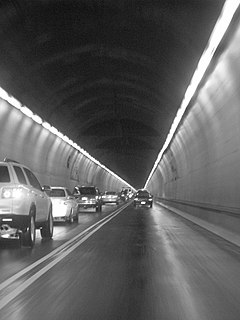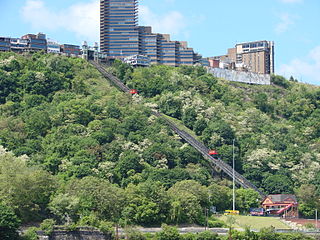 South end | |
| Overview | |
|---|---|
| Line | |
| Location | Allegheny County, Pennsylvania |
| Status | operational |
| System | Pittsburgh Light Rail |
| Start | Dormont Junction |
| End | Mt. Lebanon |
| No. of stations | 0 |
| Operation | |
| Constructed | New Austrian Tunnelling method |
| Owner | Port Authority of Allegheny County |
| Operator | Port Authority of Allegheny County |
| Technical | |
| Length | 3,000 feet (910 m) |
| No. of tracks | 2 |
| Track gauge | 5 ft 2 1⁄2 in (1,588 mm) |
| Electrified | overhead catenary |
The Mt. Lebanon Tunnel is a light rail tunnel in Allegheny County, Pennsylvania, also known as the Dormont/Mt. Lebanon Transit Tunnel, part of the Pittsburgh Light Rail system.

Light rail, light rail transit (LRT), or fast tram is a form of urban rail transit using rolling stock similar to a tramway, but operating at a higher capacity, and often on an exclusive right-of-way.

Allegheny County is a county in the southwest of the U.S. state of Pennsylvania. As of 2017 the population was 1,223,048, making it the state's second-most populous county, following Philadelphia County. The county seat is Pittsburgh. Allegheny County is included in the Pittsburgh, PA Metropolitan Statistical Area, and in the Pittsburgh Designated Market Area.

The Pittsburgh Light Rail is a 26.2-mile (42.2 km) light rail system in Pittsburgh, Pennsylvania; it becomes a subway in Downtown Pittsburgh and largely as an at-grade in the suburbs south of the city. The system is largely linear in a north-south direction, with one terminus just north of Pittsburgh's central business district and two termini in the South Hills. The system is owned and operated by the Port Authority of Allegheny County. It is the successor system to the streetcar network formerly operated by Pittsburgh Railways, the oldest portions of which date to 1903. The Pittsburgh light rail lines are vestigial from the city's streetcar days, and is one of only three light rail systems in the United States that continues to use the Pennsylvania Trolley (broad) gauge rail on its lines instead of 4 ft 8 1⁄2 instandard gauge. Pittsburgh is one of the few North American cities that have continued to operate light rail systems in an uninterrupted evolution from the first-generation streetcar era, along with Boston, Cleveland, New Orleans, Newark, Philadelphia, San Francisco and Toronto.
The 3,000-foot (910 m) long tunnel connects the Dormont Junction and Mt. Lebanon stations beneath Washington Road & West Liberty Ave. from Shady Drive East to McFarland Road at a maximum depth of 100 feet (30 m), and runs beneath a cemetery.

Dormont Junction is a station on the "Beechview" branch of the Port Authority of Allegheny County's light rail network. It is located in Dormont, Pennsylvania. The station is an important park and ride facility, featuring 132 spaces. West Liberty Avenue, Dormont's main artery, is located one block from the station, in a portion of the street that is lined with automobile dealerships. Opposite the commercial sector, a densely populated residential area is located with many homes within walking distance of the station.

Mt. Lebanon is a station on the Red Line of the Port Authority of Allegheny County's light rail system, serving Mt. Lebanon, Pennsylvania. Opened in 1987, as of 2005 it serves an average of up to 2,000 passengers a day through both rail and bus connections.
The pre-tunnel trolley street line, which ended in 1984, ran from the long-removed Clearview Loop stop on Alfred St. (Mt. Lebanon) to the intersection of McFarland Rd. and Raleigh Ave. (Dormont).
The tunnel was constructed by a technique called the New Austrian Tunnelling method, a tunneling process developed in the early 1960s that has become the primary tunneling practice in Europe. This is the first time that this money-saving technique was used for transit construction in the United States. [1]
The difference with NATM lies in the means of support required to maintain the rock cavity and the configuration of the tunnel structure. With conventional tunneling, support of the rock cavity consists of a rib cage framework of steel beams and horizontal wooden planks. A reinforced steel concrete lining is added to create a perfectly shaped tunnel. With NATM, the rock surrounding the hole becomes the support system. This is done by lining the tunnel cavity with several thin layers of shotcrete, concrete that is blown on under air pressure. [2]

Shotcrete, gunite or sprayed concrete is concrete or mortar conveyed through a hose and pneumatically projected at high velocity onto a surface, as a construction technique. It is typically reinforced by conventional steel rods, steel mesh, or fibers.
The tunnel has continuous television surveillance. [3]














